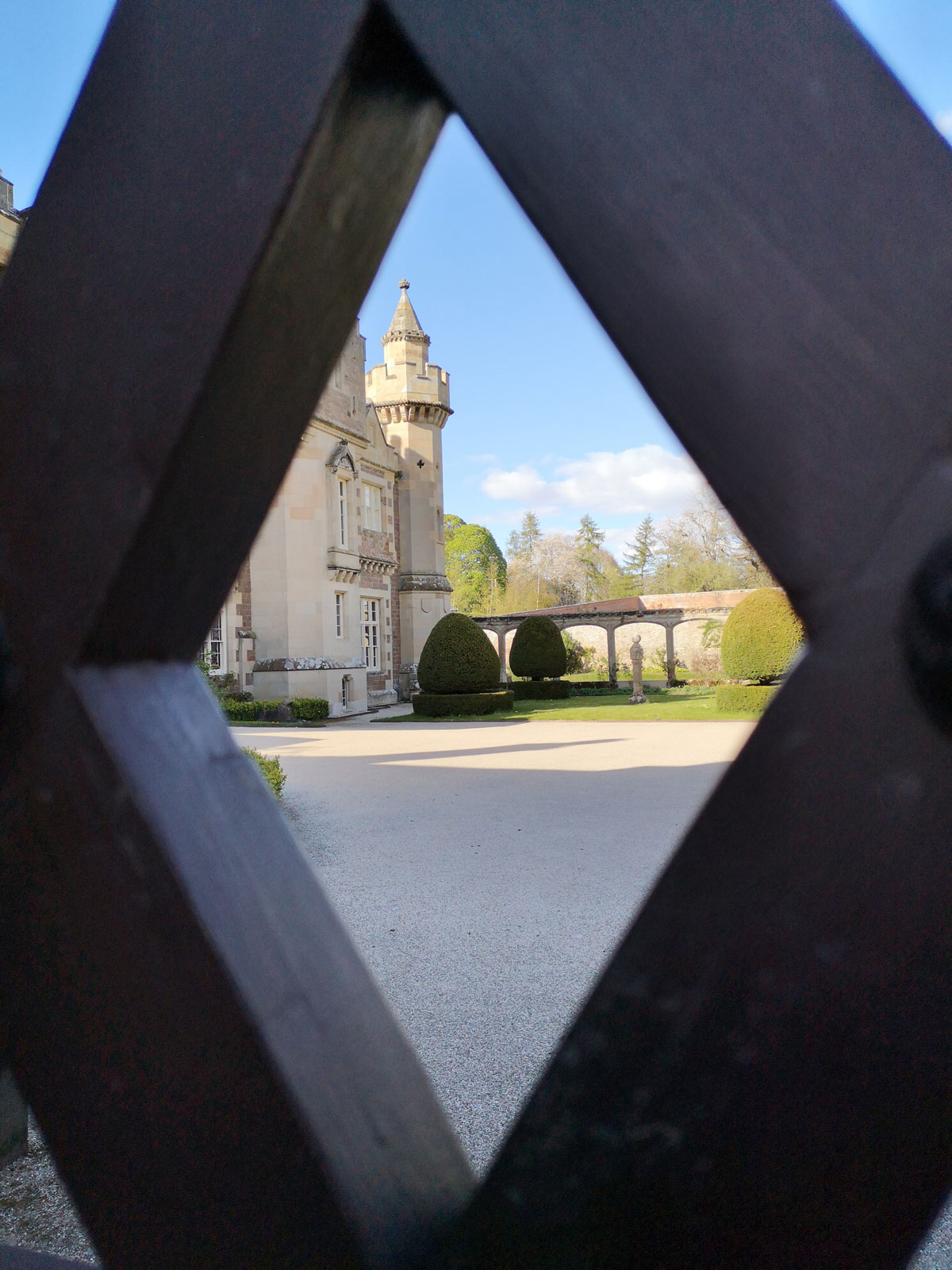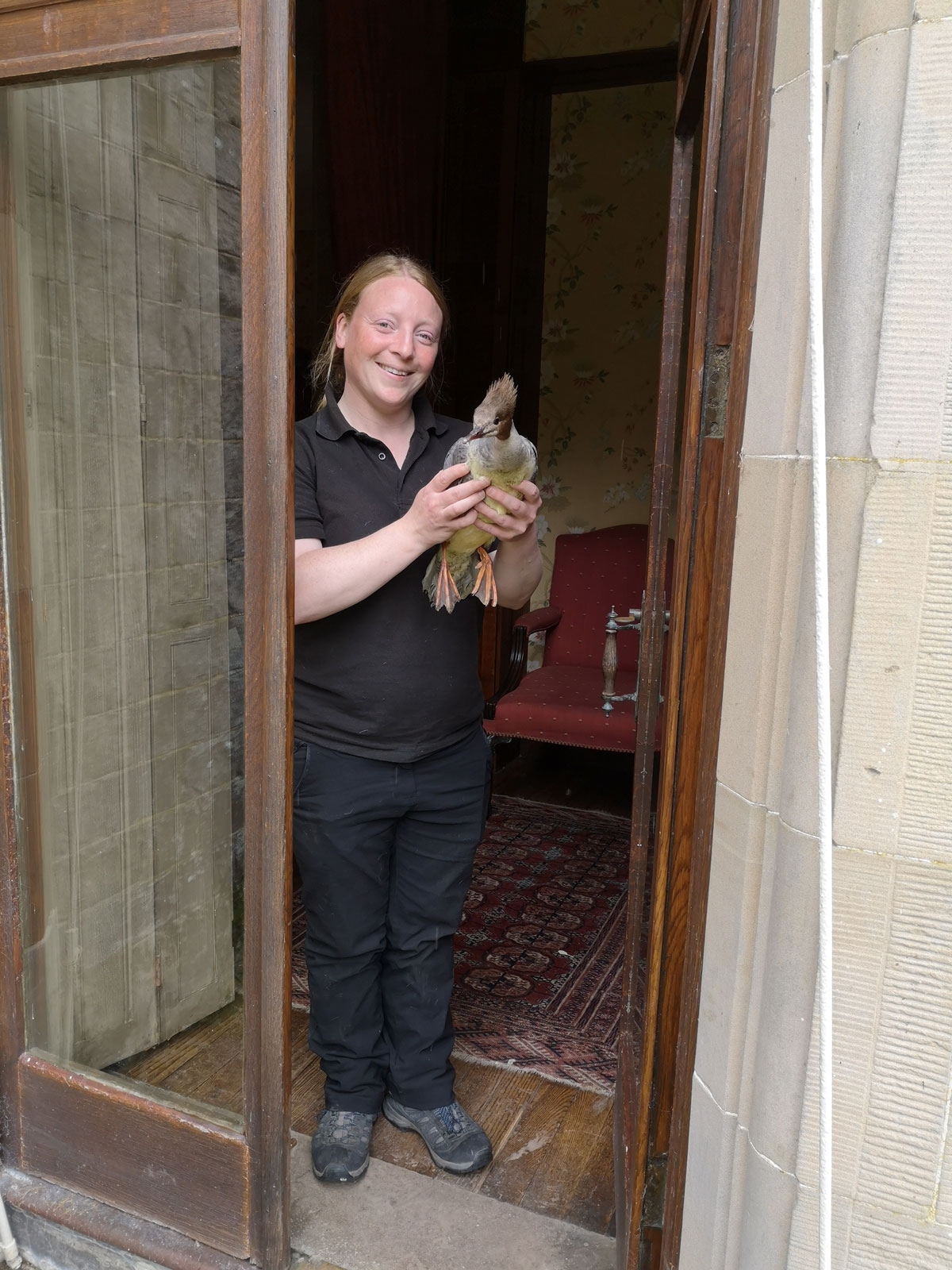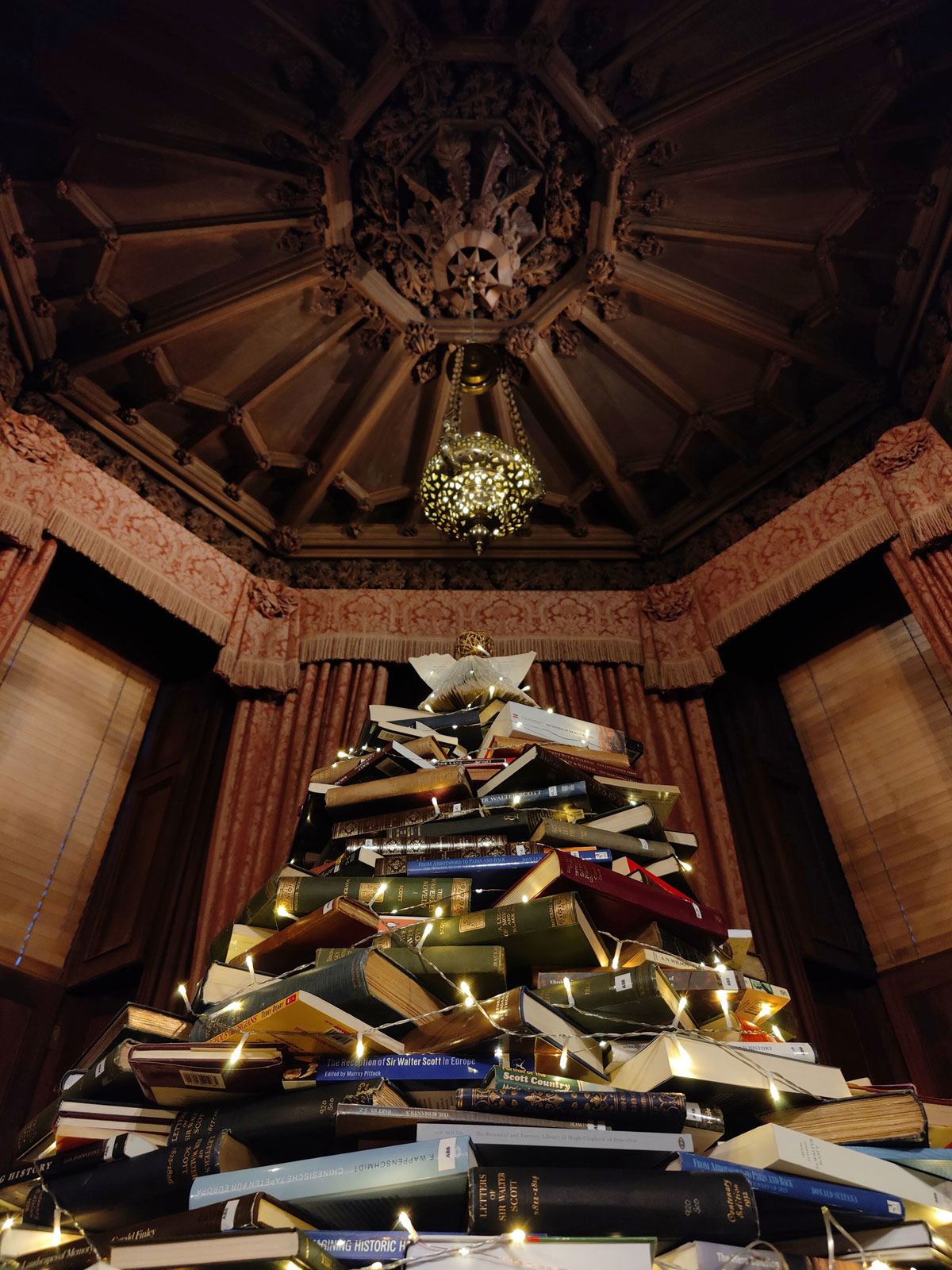Abbotsford, the early nineteenth-century home of Sir Walter Scott in the Scottish Borders, reopened to the public, following its customary three-month closure for maintenance and conservation cleaning work, on 1 March 2020 (Fig. 1). Behind the scenes there is always a great sense of momentum at this point in the year, particularly in my small department which is responsible for the care of our built heritage, interiors, and tens of thousands of collections items, alongside the visitor experience, exhibitions, and interpretation. Although it is wonderful to close the doors and take the time to give our astonishingly varied collection of historical artefacts (for the most part on open and unrestricted display) due care and assessment, and to allow the interiors to ‘rest’ from light exposure and any unnecessary environmental fluctuations, restoring the house (and indeed the gardens) to public access is always a special moment. Sometimes, in my attempts to explain the sensation to colleagues who do not work with the historic environment so closely, I use the analogy that it is a little like saying goodbye to your child at the school gates after a long holiday, or perhaps for the very first time. You do everything you can to protect a space and its contents but in order for it to have meaning, it needs to be a part of the world. As an independent charity, the Abbotsford Trust aims to open the storybook charting a remarkable 200-year history and enrich, delight, and engage our audiences, so that we can safeguard this extraordinary place for future generations to enjoy.
This sense of ‘new season’ optimism was somewhat short lived. By the second week of March, some of our volunteers were requesting to step back from their roles temporarily as the news about the at-risk demographics started to make the headlines. I think back on this frenetic period almost as if we were watching a tsunami approaching the shoreline. In the final week of opening before lockdown was imposed, we had risk-assessed the entire visitor route and staff facilities, implementing a quarantine system for anything tactile (such as tour transcripts) and removing our popular handheld audio guides from circulation ahead of the official guidance to do so. We had also made the difficult decision to suspend all site volunteering in the interests of the welfare of our community, covering our front-of-house operations with staff as best as we could. This was a challenge in and of itself as, at Abbotsford, volunteers actually outnumber paid staff by four to one, a great source of pride for our organization, which was the first independent historic house in Scotland to gain the Volunteer Friendly Award. Then, in a whirlwind of emotion, came Saturday, 21 March, when I found myself writing a difficult email to our cohort of over sixty house volunteers with a lump in my throat. The site was eerily quiet. I look back at what was foremost in my mind then and feel immensely proud of the organization I work for and its charitable heart. We were immediately concerned about volunteer isolation and loneliness and had started to consider ways that we might try and keep in touch as much as we were able, none of us thinking for a moment we would be in a comparable situation twelve months on. We remain (and have remained) committed to the developmental projects on the horizon and I assured my guides and stewards that the organization would only appear to be dormant and that these aspirations would remain firmly in our sights. I also promised them that no corners would be cut in our care of Abbotsford’s buildings, gardens, or estate. All of this came to pass, as further archaeological investigations on our George IV garden pavilion and furnace house continued unaffected, laying the groundwork for a major architectural restoration of this important structure in 2022.
The first lockdown was one of the most surreal periods of my professional life. Approximately two thirds of the staff team were furloughed, and now, looking back, it almost felt as if every waking moment was filled with scenario planning and forecasting for reopening and making assumptions about what might be possible, and when; although in truth this came in intense bursts as government updates were released. While we were stuck in this holding pattern, I combed every inch of the building regularly to check for any issues, continued monitoring for insect pests, flushed water systems through, monitored building control systems, and ensured loan items were secure. This caretaking activity was not without its bizarre and humorous incidents. I was called in one afternoon by our intruder alarm system, reporting a recurring fault in the sitting room of our West Wing, otherwise known as the Hope-Scott Wing, built by Walter Scott’s granddaughter and her husband James Hope in the 1850s. Everything was undisturbed and as it should have been until I reached the door of the offending room. On opening it gingerly, I was horrified to hear a strange wheezing noise coming from underneath the grand piano. Lampshades were sitting at jaunty angles and photo frames had been knocked over. As I crept closer, I saw what I thought initially was a bird of prey breathing heavily in the shadow of the family piano. It was certainly of a substantial size. Clearly in some distress, the noise I had heard was actually a hissing, such as you might hear from an aggravated goose or swan. After calling on the services of the SSPCA who were able to gently capture our avian intruder, we discovered that our feathered guest was a female goosander, presumably hailing from the waters of the Tweed that runs just below the house (Fig. 2). How this waterfowl ended up falling down our chimney remains a mystery but ironically, she remains Abbotsford’s only house guest between April and July 2020!
Obviously, this is a rather fun cautionary tale in and of itself regarding what it is like to care for historic buildings, but it also has an interesting curatorial angle. A great deal of my time and focus is absorbed by the life, legacy, and literary output of Sir Walter Scott (1771–1832) and his home as a three-dimensional expression of his artistic, antiquarian, and literary interests. But historic houses are not immutable, and Abbotsford remained both a home and a popular tourist site throughout the 172-year stewardship of Scott’s descendants. These members of the family and the household and estate staff they employed are all part of its incredible story. Naturally, the unprecedented disruption of Covid-19 invited parallels with wartime Britain, and whether for this reason, or a broader sense of needing to place this astonishing period we are all living through in historical context, I carved out some time to do something that had been on my curatorial wish list for years. I photographed every single page of a family journal started by the Honourable Joseph Constable Maxwell-Scott in 1874 (the year he married the last living direct descendant of Scott, Mary Monica Hope-Scott of Abbotsford), and then carried on dutifully by his son, Walter Joseph Constable Maxwell-Scott, right up until 1952. I have looked at this volume multiple times over the years but never in its entirety and taking the time to transcribe the entries chronologically gave me a deeper appreciation of the other seismic moments in Abbotsford’s more recent past. The bulk of the journal charts travel, military careers, births, deaths, and periods of illness, but there are passages of deep emotion and real peril where Abbotsford’s future and financial security hangs in the balance and where visitor seasons are disrupted or deeply disappointing. This enhanced knowledge of the storms that the place had weathered over its long life certainly brought me comfort, perspective, and resolve at a very challenging time. Given that the family had been keeping visitor books continuously since the house opened in 1833, and that the Trust has continued that long tradition, it is apt that we consider adding this story of our surprise goosander to our 2020 volume for the archivists and curators of the future!
It is a measure of the sort of organization the Abbotsford Trust is and wants to be that April 2020 also saw us commit to spearheading the national and international plans for the 250th anniversary of Scott’s birth across 2021 and 2022. We had had our eyes firmly fixed on this landmark year for some time within our ten-year master plan and had participated in various scoping discussions with partner organizations to see what collaborative plans might take shape. In the early months of 2020 we were poised to invest seed funding we had been awarded towards consolidating the project. Covid-19 provided the catalyst we needed to meet this challenge head on. ‘Walter Scott 250’ was no longer something that we hoped to participate in or make happen, it was now fundamentally a part of our recovery trajectory from the pandemic, both for Abbotsford and for its friends and partners across the cultural, literary, and academic spheres, offering hope, optimism, and opportunities for collaboration. I started a temporary secondment as project manager of ‘Walter Scott 250’ for this developmental phase of work, commissioning the anniversary brand and its guidelines and the structure of our dedicated website, setting up working groups of partnership organizations across the cultural, literary, curatorial, and academic sectors and working on the creative proposition for the programme at Abbotsford itself. By July we were coming to realize that the Abbotsford programme needed to be more resilient to the disruptive force of Covid-19 than we had first thought, and we took the time to separate it into two stages, prioritizing high impact visual installations in 2021, segueing into what we hope will be a return to more traditional events and performances with live audiences in 2022. This decision has allowed us to focus our energies on the launch event for the national programme, transforming Smailholm Tower, a medieval peel tower in the Scottish Borders about ten miles from Abbotsford, into the canvas for a stirring light show, introducing Walter Scott’s formative years here and his love of the Scottish landscape, history, and storytelling. If you missed the show held at sunset GMT on 20 March, World Storytelling Day, you can still enjoy footage on the anniversary website.
This intervention will not be the first of its kind and you can look forward to more awe-inspiring landscape art within Abbotsford’s celebratory programme later this year and into next. In November 2020 I handed over the reins of project management to a new full-time colleague, able to give more time to the critical delivery phase of this ambitious project, now facilitating over fifty partner institutions. Meanwhile, I continue to support the content and storytelling behind the Abbotsford programme and in developing and delivering collaborative lectures, projects, and exhibitions with partners. If you are interested in following the programme over the course of the next two years, you can do so now by visiting the anniversary website.
Preparing to reopen the house was, no doubt, a story shared by many other businesses — a dizzying flurry of new signage, health and safety protocols, and capacity assessments. Abbotsford is not a grand or a stately home in the typical sense, despite its appearance of a castle in miniature. Rather, it is a comfortable domestic villa with rooms proportionate to its overall scale and, testament to the antiquarian enthusiasms of its creator, it is simply brimming with interesting items on open display. Key rooms such as Scott’s Study, perhaps the most evocative and intimate of all our interiors, are no larger than the average size of a doctor’s consultation room. The biggest challenge for us was actually an interpretative one; for a number of years the Abbotsford experience for individual and family visitors had been based upon a series of high-quality audio tour options, allowing the rooms to remain as Georgian time capsules, free from the interventions of twenty-first century labelling. This approach has attracted widespread praise from our visitors over the years and the audio guide system consistently features as a highlight in their reviews. We knew that we could not simply move to transcripts wholesale and provide mass-quarantine areas for such material, and neither were we convinced that this would offer visitors an immersive and enjoyable experience, particularly at a time where opportunities for escapism were perhaps more important than ever before. So, following some research, I started the process of transferring our audio experiences onto a progressive web application, enabling users to access their personal mobile devices as their own audio guide. This system was implemented over the early portion of the summer and launched to the public in August 2020 when the house opened its doors once again, complete with a new introduction personally recorded by me as a thank you for their decision to visit us. A small stock of transcripts remained on standby for those visitors who were not comfortable with the technology.
Initially, we opened for four days a week, uncertain as to what levels of demand would be and naturally anxious to monitor our operating costs. Once it became apparent that cultural experiences were not just of interest but of clear mental and emotional benefit to visitors and that our volunteers who had returned also felt hugely buoyed by the opportunity for socially distanced interaction with one another and with our visitors, we moved back to our traditional seven-day model. Although we scaled the number of opening days back during England’s national lockdown in November, we managed to remain open from August right the way through to 20 December. Not only did we achieve this relying on the unwavering support of about one third of our volunteers, but we also designed and developed a new and historically authentic Abbotsford Christmas experience. Visitors were invited to step back in time to the winter of 1824 and a season of celebrations for the Scott family following the completion of building the house and gardens. They were treated to the interiors dressed beautifully for Christmas with herbs, spices, and greenery, witnessed a very special tree with a literary twist, and listened to a special edition of our audio tour where they could walk in the footsteps of Scott’s house guests during the ‘daft days’ of the festive period at Abbotsford (Fig. 3). All of this illustrates that as well as challenging us on every level, professionally and privately, the pandemic has also made organizations bolder and more determined to trial new things and break new ground. The foundations laid in December 2020 give us the confidence to make a festive offer a fixture in our annual calendar from now on.
As I write this, we find ourselves waiting and wondering once again, but in this monumental year for Scott we intend to make the most of the opportunities it brings as we have done throughout this crisis, and to continue to think creatively and positively about how we can make Abbotsford the best it can be, both now and in the future. After all, as a very wise man once said, ‘adversity is to me, […] a tonic and bracer.’1
Notes
- The Journal of Sir Walter Scott, ed. by W. E. K. Anderson (Edinburgh: Canongate, 1999), 22 January 1826. [^]



